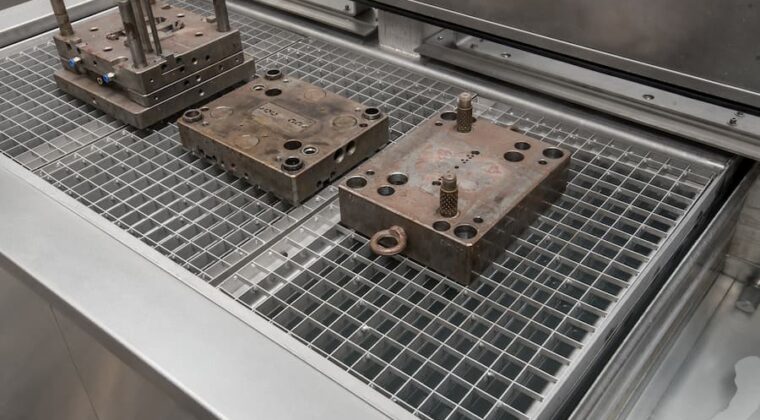As specialists in ultrasound cleaning, UltraTecno wants to contribute improving this industry and for that we offer our technology to get injection moulds in perfect state, injection after injection process. With the use of ultrasound to clean moulds, release agents are removed, metalic waste such as aluminium and brass are eliminated, and it also effectively cleans plastic and rubber rests. Our ultrasonic cleaning of the mold leaves mold surface perfectly clean. Its effective cleaning makes it possible to attain an excellent finish of the surface of the end product, thus reducing rejections due to quality control.
Thanks to 50 years of experience and research, we have achieved the highest quality ultrasound cleaning results in the mould industry. Ultrasonic cleaning tanks manufactured by Ultratecno are used in the whole world for cleaning any type of injection mould.
Our ultrasonic cleaning process works together with water based chemicals, which are much safer than solvent based chemicals traditionally used in this industry. And these type of water based solutions are also more eco-friendly than solvent based chemicals, so they are better for your employees and the environment.
Before and after injection cleaning
The benefits of using ultrasound for demoulding agent cleaning
A release agent, also called mold release agent, is a chemical applied on molds surface to avoid materials bonding to mold during production. The rests of material on mold surface have negative consequences on quality of finished product. Release agents facilitate separation of the mold from the material involved in mold release, plastic release, die-cast release etc. So how to clean the mold? With traditional cleaning methods, a long clean-up is needed and it has an impact on global manufacturing efficiency.
Ultrasonic cleaning reduces the consumption of separating agents. It prevents undoing the first injections due to old debris, it increases the commercial appeal of your range and it homogeneously cleans inside orifices. Also, the cost of manpower is reduced as fewer consecutive cleanings are required and there is an increase of speed and quality of production.
One of the key attributes of a release agent is time of permanence. A semi permanent release agent has the advantage that does not need to be reapplied for every cycle of use of the mould.
The semi permanent release agent must be applied to a clean and dry surface without any rest of dirt, rust or other contamination. And with this purpose, UltraTecno multistage ultrasonic cleaning systems are the most efficient tool to perfectly clean the mold. Ultrasonic cleaning and drying allows the release agent to properly bond to the mold, during multiple operations, improving efficiency of molding processes.
Ultrasound applications
Via the production of bubbles using the cavitation process, perfect cleaning of the injection moulds is achieved without leaving any type of residue that affects the quality of the finish.
The different applications of ultrasonic cleaning include moulds for rubber, metal and plastic injection, aluminium, zamak, thermoformed moulds and extrusion moulds.
Ultratecno recommends completing cleaning process with rinsing and drying tanks, to eliminate possible residue on the mold, in order to get perfect cleaning results.
Share with us your project to clean the mold and we would recommend you the best approach. It is necessary to share with us the size and material of the mold, type of injection material and if it is required demoulding spray removal. It is also very useful to know if you have any issue with mould release or final product surface finish.
Based on this information, we would prepare an ultrasonic application guide with recommended cleaning procedure including the information about ultrasonic tank size, type of water based detergent and cleaning temperature. UltraTecno also offers the possibility of making a parts cleaning test in our factory, in Valencia, Spain.
Permanent mold
Permanent mold casting is a process of metal casting that uses a reusable mold (permanent mold) for many castings. Casting metals are aluminum, magnesium, copper alloys, zinc, etc. but also iron and steel (these last ones cast in graphite molds).
The most common casting process of filling molds uses gravity, so metal enters into the mold, cools and solidifies. The mold is opened, the casting removed and mold reused. Typical products made with permanent mold casting are components as gears, pistons, pipe fittings, fuel injection housings etc.
For making permanent a mold, the first step is cleaning for preparing surface for treatment. Ultrasonic cleaning, thanks to cavitation, is able to achieve a micro-brushing effect with homogeneus and perfect surface finishing, even in holes and cavities of the mold.









